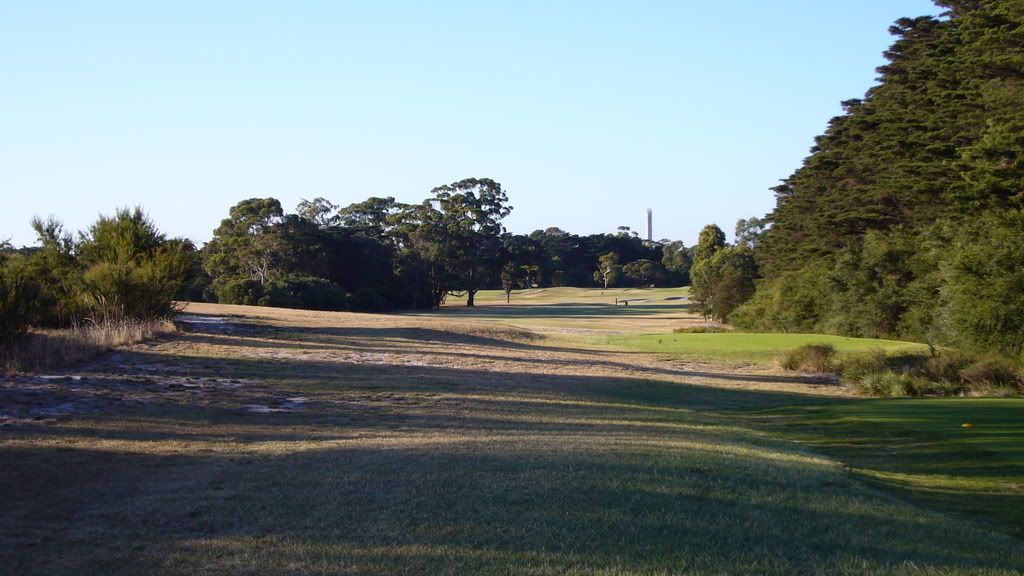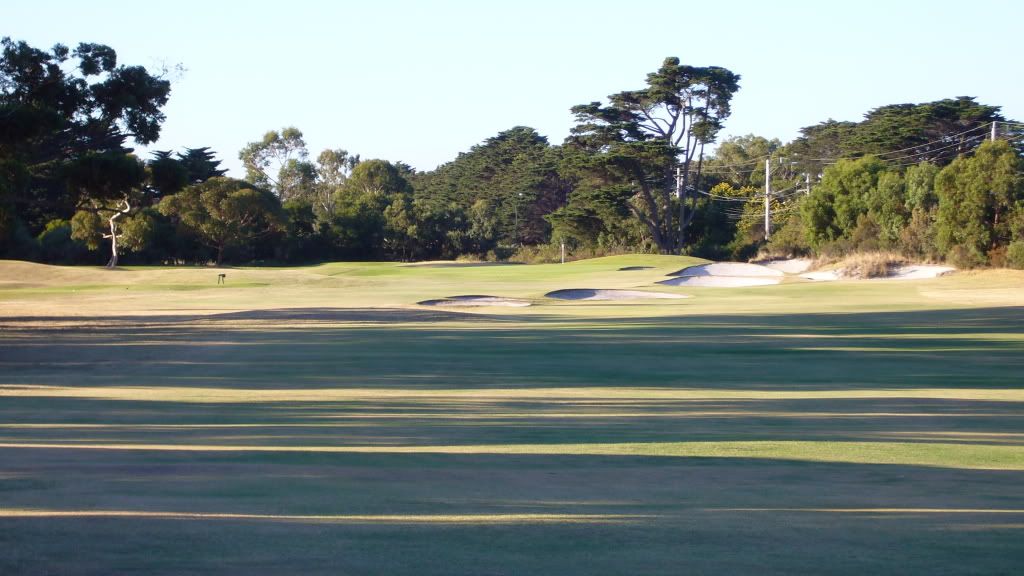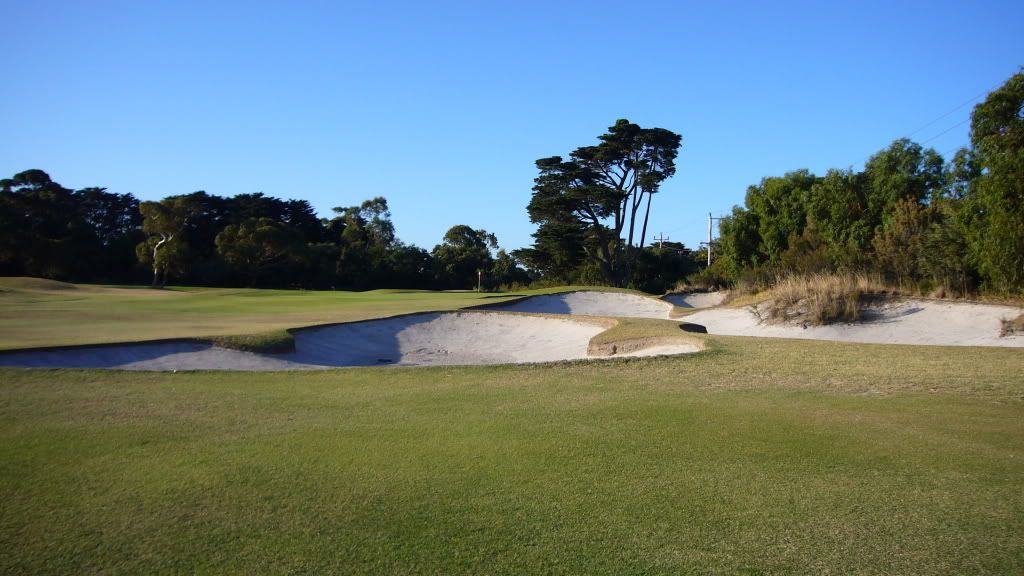As much enjoyment as the 17th provides -- we will get to the use of bunkers en echelon in a minute -- personally it stands for a moment that embodies the membership's successful navigation of honoring and continuing its narrative of professional tournaments yet without soiling its architectural lineage and excellence.
Standing on the 17th tee, having just made a meal of the 16th, the hole that day having been located in a distinctly not-easy spot, a member remarked the 17th might be lengthened not by changing the hole but simply by having the pros tee up back on the unused 16th tee.
"Why not," he mused. "It beats ruining a great hole 51 weeks a year." (Note: Mike C and I discussed this one a while back; can't find the thread...)
Let it be noted this is a course whose membership not only welcomes professional tournaments but worships its tournament history. The members maintain a strong oral tradition out there. This is the bunker Allenby got lost in, this is the green Els putted off, this is the hole where Trevino lost his mind, here's the hole the Argentine nearly drove in '59...
Thomas Jefferson wrote the test of a first-rate mind was the ability to hold two diametrically-opposed ideas in one's head at the same time. Does that not describe the ability of a club's membership to welcome the best golfers yet not succumb to them?
(Sadly, it seems as though the day is coming soon when those twin objectives will be impossible to square. Here's pulling for the tournament side to lose.)
The tee shot on 17, a 558-yard par 5, is perhaps even less inspiring than that of the 15th (RME3). There's not much to look at, with trees blocking the view to the green down the right (too bad) and a line of scrub off in the distance.

Ah, but only a fool relaxes his concentration, for here he once again must be boldly aggressive to unlock his shot of privilege.
The fairway angles off to the right, yet he must ask
not how much angle he is willing to cut, and not simply because of rough and scrub down the right, which would be the primary issue were this a course of lesser, even standard quality, but because the right side is the wrong side. It's a reverse dogleg, and interestingly earns this distinction via the use of bunkers en echelon.
Down the right gives him a shorter if still long second to the green, but he must carry a bunker just short of the green.
So his better angle is from the left side of the fairway, but as this position is farther from the tee it will give him a longer second and now he's got a difficult decision.
The bunkers appear first on the left side of the fairway about 80 yards shy of the green and thence run all the way to and along the right side of the green.
So let's suppose the golfer, playing from the member tees, stripes a drive 270 yards right down the left side of the fairway. Here are the numbers on his next decision: 200 to carry the bunker, 250 to the front, bunkers just off the direct line all the way down to the green. (If he carries the bunker he will get a lot of run out of the flat, dry turf -- but of course that calls for a low, running shot that must nevertheless carry 200 yards.)
The second-shot angle from the "ideal" left; POV is closer than landing spot of drive The view from a bit farther back: note the subtlety of the hill into which the bunkers and green alike are nestled; many golfers will not realize their second shots are uphill.
The view from a bit farther back: note the subtlety of the hill into which the bunkers and green alike are nestled; many golfers will not realize their second shots are uphill.
See the snare? A drive down the right brings a shorter shot, a drive down the left a longer shot, but the bunker challenge remains the same. Suppose our golfer, again playing from the member tees, manages a true power fade: 295 yards, but a yard or two right of the fairway. From that angle, despite his booming drive, he still must manage a carry of 190 yards -- and from that point he has zero margin for error to the right of his line to the green.
View from the right; POV is closer than likely landing spot of drive A closer view yet of the beautiful problem, this time from an angle down the extreme right (i.e., the shortest line from tee to green). A sublime green, like the 1st nearby built up ever so gently above grade.
A closer view yet of the beautiful problem, this time from an angle down the extreme right (i.e., the shortest line from tee to green). A sublime green, like the 1st nearby built up ever so gently above grade.
No, that's not quite right. From the left the carry is a little easier, not simply because it is a little shorter but because a runway of apron is available past the bunkers and up to the green. There's more room.
Adding to the fascination of this privilege shot - pay attention, this is really neat - left of the green is wide open, just as we saw on (right side of) the 11th (RMW12). Look at the previous picture, left of the green: a flat and flat-calm slick of grass. The golfer down there in two, even as far left as the 14th tee (RMW4), should walk off the green a few minutes later with no worse than par.
In fact, getting up and down for birdie from most areas on the left seems a reasonable proposition. And so we are back to the monkey hand trap: grip hard for eagle or a little lighter (bail out or lay up) for birdie? Of course, eagle risks sand, long bunker shots -- possibly even bogey or at best a demoralizing par. A lighter grip means loss-cutting in favor of somewhat-assured par (there are no guarantees out there, not with these greens), possible birdie.
And of course this assumes one has striped his drive...
So what
is the risk reward math? Easy par (left) versus eagle (right)? Slim birdie (left) versus easy birdie (right)? Easy par (left) versus - my head hurts and I'm not a very good thinker and next time maybe I should make things easier on my brain and off the tree just aim right.
Fascinatingly, we have just shared a fairway with the 14th (RMW4) -- but owing to the scrub, the angles, and the "obverse" to the bunkered side of the hill on 14, do not realize it until we are well down the hole.
Mark